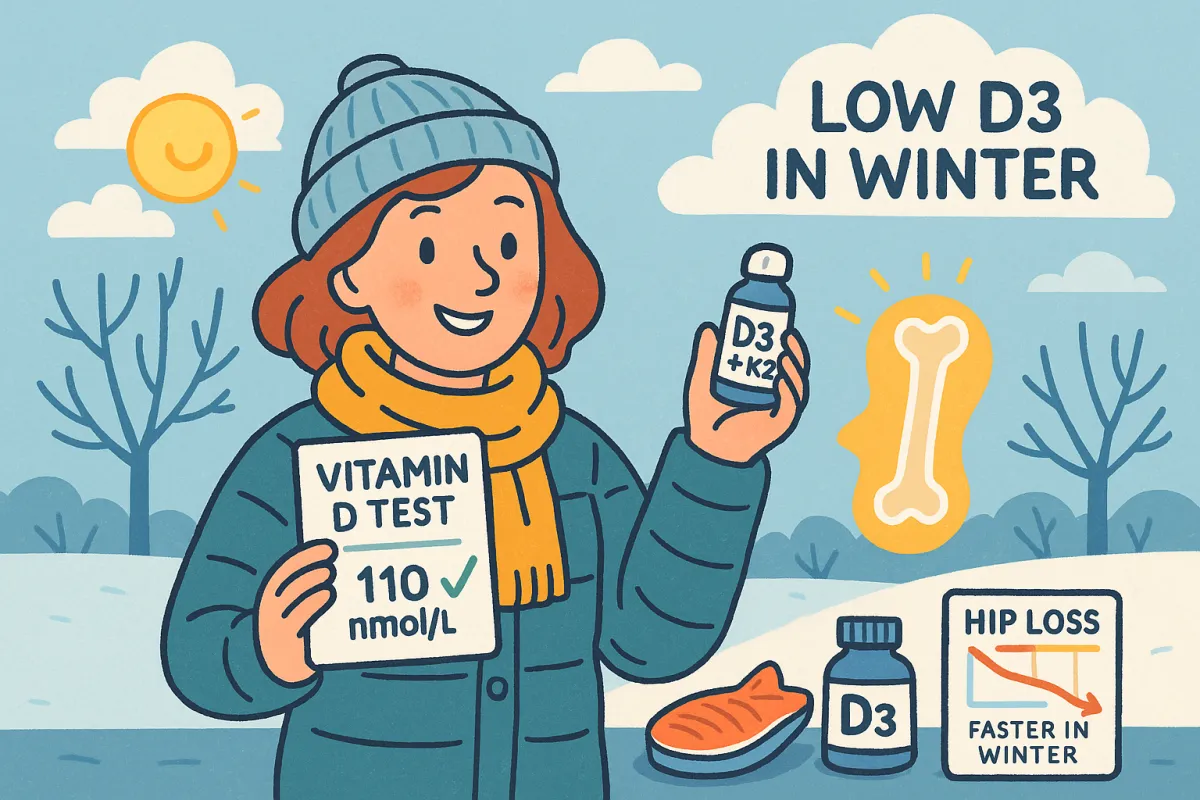
Vitamin D3: The Unsung Hormone That Anchors Your Bone Health
We often hear about vitamin D like it’s just another supplement. But vitamin D3 is actually a hormone, and it plays a central role in helping your bones absorb calcium and maintain density.
Yet many people walk around low in D3 without knowing it — especially in winter — and that can quietly set the stage for bone loss.
Let’s unpack what makes D3 so important (and how to know if you’re getting enough).
What D3 Actually Does for Your Bones
Vitamin D3 (cholecalciferol) does two major things:
Helps absorb calcium from your gut — without D3, only about 10–15% of dietary calcium gets absorbed.
Regulates calcium levels in your blood by helping manage parathyroid hormone (PTH). When D3 is low, PTH rises, which triggers bone breakdown to keep calcium circulating.
In other words: without enough D3, you don’t absorb calcium efficiently and you may start losing it from your bones.
Here’s What Most People Don’t Realize
🧪 A 2013 study in Bone showed that bone loss in the hip accelerates during winter — especially in people with low D3 levels.¹
This is one of the first signs that vitamin D status has a real, seasonal impact on bone.
Even in sunny countries, vitamin D levels often plummet during winter, especially for those who:
Are indoors most of the day
Cover up or use sunscreen regularly
Have darker skin tones
Are older (conversion in the skin slows with age)
Live in southern states or higher latitudes
The problem? Most people never test their D3 — or only do it once.
Why Regular Testing Matters
Vitamin D3 is one of the few bone nutrients you can actually measure, yet it's often left out of routine check-ups.
Many labs list “normal” as 50–75 nmol/L (20–30 ng/mL) — but that may not be optimal for bone health.
A more supportive target for bone strength is:
75–125 nmol/L (30–50 ng/mL)And many functional medicine practitioners recommend aiming even higher:
100–150 nmol/L (40–60 ng/mL) — especially in older adults or those with a history of bone loss.
⚠️ You can feel fine with low D3 — and still be losing bone quietly.
That’s why testing once a year — ideally in late winter or early spring — gives you the best insight into your baseline.
Should You Supplement?
Most people benefit from 1,000–2,000 IU per day as a general maintenance dose — and sometimes more if your levels are low.
Look for:
D3 (cholecalciferol) — not D2
Liquid drops or softgels (better absorbed)
A combination with vitamin K2, which helps direct calcium into bone
If your D3 levels are very low, your practitioner may recommend higher doses short-term (e.g. 5,000 IU/day), but this should be done under supervision.
Food Sources of D3 (Not Many)
Unlike other nutrients, very few foods naturally contain D3.
Source(Approx.) D3 Content
Salmon (100g) 400–600 IU
Sardines (1 can) 300 IU
Eggs (2) ~ 80 IU
Fortified plant milk ~100 IU
That’s why sun exposure or supplements are usually necessary — especially in winter.
Final Thought
Vitamin D3 isn’t just a sidekick to calcium — it’s a hormonal anchor that regulates your entire calcium economy.
Don’t guess. Test it yearly. And consider topping up during winter months — because even small drops in D3 can set off big changes in your bones.
Reference
Chow, R. et al. (2013). Seasonal variation in bone mineral density loss in the elderly: the impact of vitamin D deficiency. Bone, 55(2), 423–428.
